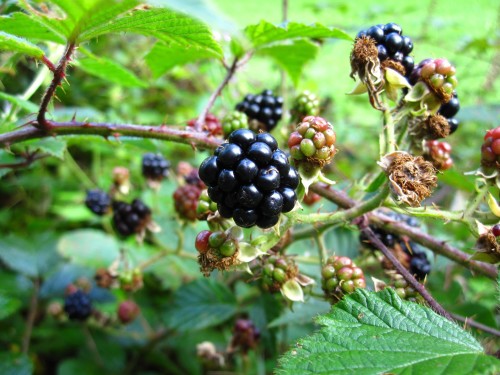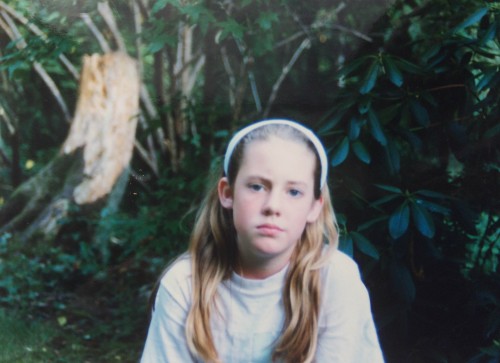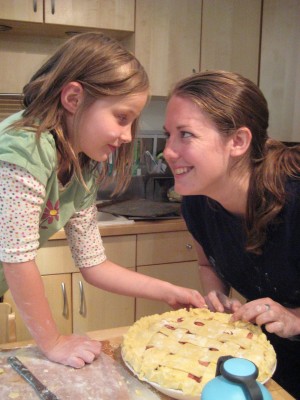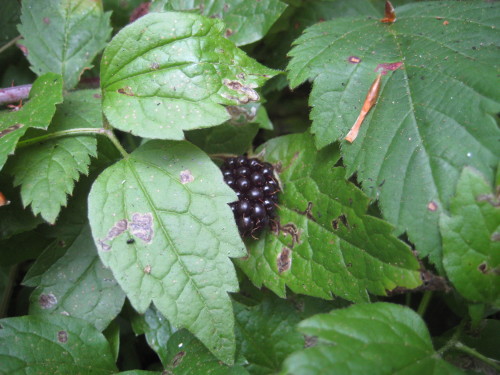IT IS a treasure hunt and a battle, a dance and a game. I search for my quarry in thickets of grass, on crumbling tree stumps, and amidst dense English ivy, which is invasive, or woody salal, which is native and just as tough. On a green July afternoon I walk slowly down the quiet roads of my hometown, scanning the ditches and the underbrush. The Northwest sun filters through the maples and cedars; the air is still. Everyone else is at the beach or the country store for ice cream. I bend down to run my fingers along the bottom of an overgrown laurel hedge. There, a tangle of slim whitish vines. Here, a purple clump half-hidden by leaves.
A woman passes me in jogging clothes. She stops, peering curiously at me and removing her earbuds. I feel exposed and mildly ridiculous; I am knee-deep in brush about five feet off the road, and there is no apparent reason for it.
“What are you doing?” She asks, at last.
“Looking for blackberries,” I say. I peg her as a newcomer, or a visitor from California.
“No!” she exclaims. “Isn’t it early for them?”
“Not these kind,” I say, but I can tell from her too-wide smile that she doesn’t believe me.
“Sounds like fun,” she says, carefully, as she backs away and replaces her headphones.
At the end of a driveway, an angry old man in a red vest comes out to tell me it’s private property. “Just berry-picking,” I stammer, surprised until I see the Tea Party sign on his lawn. Most people in my town lean toward hippie, unless they’ve been around as long as my family has, but even then you can usually assume friendliness. Another newcomer, then.
As a girl I spent countless hours in these woods. I had favorite spots: a damp hollow behind a fallen tree, where I could read or pretend to be a pioneer; a thicket of sword ferns that provided good cover during hide-and-seek; the marsh near my cousins’ house, full of salmonberries and sneaky river otters. Indianola remains small, but then it was even smaller; the trees stretched more or less unbroken from behind my house to the crest of the hill, and beyond that through federal tribal land, all the way down to the north peninsula coast. Seattle lies across the Puget Sound, just close enough to make a long commute there feasible, but growing up, it always seemed worlds away. Indianola belonged to me. It was possible to spend days devoured by its trees, emerging only for snacks. The forest was forgiving, in its impartial way, and it was safe.
Before my parents’ divorce, my father controlled our finances and allotted paltry amounts for the grocery and clothing budget. After the divorce, my mother struggled to keep the house, we did not have health insurance, and there wasn’t room for even the small luxuries we sometimes enjoyed before. The woods were a sanctuary, the berries a gift freely given.
It takes most of a day to gather enough berries for even a single pie. On Loughrey Street – the gravel part of it, just where it bends – I climb up a bank, having spotted a bunch of tiny, wild berries in the mess of ivy. I’m a little nervous because I’m close to someone’s yard, and there’s a dog barking; these aren’t folks I know. My foot sinks into a rotting log and I fall forward, jerking my ankle. The dog barks louder. Still, I shake off my foot and inch forward. To pluck the berries free, I must snake my hand between the fine, vicious thorns. They catch on my wrist anyway, and leave raised red marks that sting.
I find more clusters beneath overlapping leaves. As is often the case, the visible berries are harbingers of a greater, hidden bounty. The ripest ones fall into my hands, unresisting. These, I eat: they’re too soft to keep, and too sweet to ignore. To bite into one of our little wild blackberries is to encounter the intense, wine-rich flavor of the forest during the summer. I have eaten fresh mangoes in Nicaragua, roasted hazelnuts in Spain, and avocadoes straight from the tree in California, but none of these compare to my wild blackberries. I come home to visit so that I can search them out. They taste like the sun, damp earth, and honeysuckle, and like none of these things. They taste like home.
* * *
This wild blackberry is officially the species rubus ursinus, Latin for “bramble bear,” so named because bears love to snack on it. It’s also known as the trailing blackberry and the Pacific dewberry, among other monikers. Widespread from British Columbia to California, the wild blackberry isn’t harvested commercially, but it is the progenitor of the better-known marionberry and loganberry.
My family is not the first to prize the trailing blackberry. Native Americans throughout the region ate it fresh and dried into pemmican, or steeped the unripe fruit for tea. Its name in Lushootseed, the original language of many area tribes, is gʷədbixʷ, and July was known as the month of the blackberry. My hometown sits on the Port Madison Indian Reservation, seat of the Suquamish Tribe. It is the smaller of the two towns on the reservation and is dominated by white families. Eddie Carriere, a prominent Suquamish elder, lives in a beachside home in Indianola; he also owns swaths of land above town. One summer he let my cousin and I pick trailing blackberries on some of that land, a horse pasture full of scratchy underbrush.
Hot and sweaty, we tied cut-open plastic milk jugs to our waists in the style of the old cedar picking baskets. It took less time than usual to gather the fruit, which proliferated in the dry grass and along the barbed wire fences in great clumps. Afterwards, of course, we made Eddie a pie. Eddie loves pie.
Growing up, I didn’t know the berry’s history, but I did have a strong sense of its unique character. I knew that it belonged to the land in a way that the Himalayan blackberry did not. The Himalayan berry is what most Seattleites picture when they hear “wild blackberry.” Though its fruit is oversized and sweet, this invasive plant is the scourge of gardeners and conservationists throughout the region. Introduced by famous botanist Luther Burbank in 1885, the Himalayan blackberry was prized at first for its abundant growth. It has since taken over the highways, parks and alleyways of the West Coast, and is now classified a noxious weed. It comes back with a vengeance unless its large, stubborn root system is completely removed.
I have a love-hate relationship with the Himalayan berries that congregate behind my house in southeast Seattle. The fruit has a mellow, juicy appeal that’s synonymous with summer. Still, I’d take the taste of the trailing blackberry over the Himalayans anytime. I have thought of planting the little wild blackberry in my yard, but it seems incongruous. I don’t imagine it would enjoy city life.
Rubus ursinus thrives in dense forest and clear-cuts alike. Indeed, the wild blackberry flourishes in “disturbed” areas. According to the US Forest Service, “it is particularly well represented following ‘catastrophic disturbance’ in Douglas-fir forests of the Pacific Northwest.” After the eruption of Mount St. Helens in 1980, the trailing blackberry increased rapidly in the mudflow wasteland following the disaster. It was one of the first species to come back.
* * *
The winter that my father left, I was nine. My mom had an education but no job. I remember standing at the top of the stairs and listening to my mom and grandmother in our living room, murmuring about whether we could keep the house. I was angry with my father for leaving and with my mother for making him leave, though I didn’t allow myself to think long about this. Instead, I focused all of my unease on the fear of poverty, which had always nipped at our heels and had now arrived with a snarl.
Riding the bus to school the next day, I slid down the brown plastic seat and pressed my knees up, nearly folding myself in half. The route took a long time along forested roads. I tried to imagine living somewhere else, even the next town over, and I could not. The other kids tossed crumpled paper balls at each other or stared out their own windows, roundly ignoring me, as was often the case. The wealthiest kids had dentists or civil engineers for parents, and the poorest kids lived in trailers on welfare. My place on that spectrum was beginning to matter. I hungered for the name-brand jackets that the girls on my soccer team wore, and for the toys I saw on TV that my parents would never buy.
Not long after, a firm knock on our front door startled me up from the pages of Little House on the Prairie. No one ever knocked. Our visitors were known to us and generally came right in.
I opened the door to our neighbor from across the street, Mr. Healy. I didn’t know him well, but had seen him often as we played in the yard or rode bikes past the church. His family attended that church, but we did not, because we were Catholic and had to drive to Poulsbo for Mass.
Mr. Healy held two brown paper grocery bags. A few others sat at his feet. In one, a bottle of Miracle Whip peeked out from behind a massive can of green beans. My mother did not buy Miracle Whip. As health-conscious as she was frugal, she favored making large pots of chicken and rice soup that we ate for days. Something about that strange, banal food made me nervous. It didn’t belong on our porch.
“Over at the church, we were thinking about your family,” Mr. Healy said. His voice rumbled like a father’s in a sitcom.
I didn’t know what to say. I knew about food drives; my siblings and I gave cans of vegetables when there was a collection at the school, secretly relieved to get rid of them. One of my friends had found it hilarious to tuck a can of dog food into the plastic bin the year before.
“We don’t need those,” I said. My daring startled me. Would I get in trouble for being so rude?
“Sure, you don’t, but it’s the winter,” he said, as if we were the Ingalls family with crops to worry about.
Mr. Healy left the bags on the porch with the kindest, softest, most terrible smile. It was a smile meant for the poor family across the street, a family I didn’t recognize as my own.
* * *
The Northwest woods offer plenty of food. Mushrooms like the chanterelle are prized by fancy restaurants. Young nettles can be boiled. Licorice fern roots are sweet. Salmonberries ripen first, too mellow and watery for pie. Thimbleberries are soft and seedy, blackcap raspberries tart, and red huckleberries zippy and bright. Late in the summer, the Himalayan blackberries explode with their heavy, easy-to-reach fruit.
We didn’t rely on the forest for our sustenance, of course. My mom knew how to make our food stretch. We made it, in fact, without food stamps. She had gone to the Department of Social and Health Services to apply for them, but as she tells it, the social worker turned her away. “You have a Master’s degree,” she’d said to my mother. “You’ll find work!”
My mom doled out portions carefully. We didn’t usually get seconds. Treats were reserved for certain weekend nights, when she’d have one of my siblings place a scoop of ice cream in each bowl. When it came to food, a sense of competition never quite left us. I’d scream in frustration when I picked up a box of cereal only to find it empty. Once, when I refused to let my brother taste the cookie dough I’d made, we ended up in a brutal fistfight.
And yet, we didn’t go hungry. My grandparents lived a half-mile away and I could push open their sliding glass door any time for a ham sandwich, a fistful of Oreos, and a glass of milk dosed with Hershey’s syrup. My grandfather, the mild-mannered welder, showed his affection via food. He had grown up with a single mother during the Great Depression, and he made sure the pantry was full to overflowing with bargain buys. When I spent the night there, I’d wake up on the couch, my fingers tangled in the black-and-white crocheted afghan, to the sounds of the talk radio and my grandfather frying bacon.
“Eat all you want,” he’d say, when I clambered up into the tall chair at the counter. He added a glass of orange juice, sweet and strong. My mother mixed ours from frozen concentrate with extra water to make it last.
I also spent a lot of time with my aunts and uncles, who supplied granola bars, bagels, popcorn and popsicles, not to mention many meals for my siblings and I. Plus, we got free lunch at school. My favorite was pizza day.
Nonetheless, I worried constantly about food. I watched my mother’s face at the grocery store, her careful calculations. We did not have candy, chips, cookies or superfluous treats in the house. Mom bought food in bulk, opted for generic brands and carefully compared price-per-pound. Sometimes we ran out of milk and couldn’t afford more, so we mixed evaporated milk with water. Our bread came from the discount bakery in Bremerton; Mom froze it so that it’d keep. When it was too late to cook, she took the four of us to McDonalds and bought us each a single $1 hamburger, no fries or a drink.
I savored most the treats I didn’t have to share with my siblings. I hoarded and I improvised. Once, I mixed brown sugar and butter in a mug, hid in the roots of a big tree down the road, and spooned the mixture slowly into my mouth. During my brief stint in the Girl Scouts, Mom bought some cookies and hid them on top of the water heater. In the middle of the night I snuck downstairs, used a stepladder, removed a box of Tag-A-Longs and took them back to my room. There, I scarfed down the entire box.
There is one store in my hometown. (I worked there throughout high school.) The Indianola Country Store and Deli has a candy aisle just beyond the single step that separates the eating area from the groceries. Boxes of Lemonheads, Boston Baked Beans and crumbly Chick-o-Sticks were 10 cents, and then became a bit more expensive at 15 cents each. Cheapest of all were the five-cent pieces of Bazooka gum, thick as concrete and wrapped with a waxy mini-comic.
My siblings and I spent hours hovering in that aisle. If we had change, we debated carefully how to spend it. I opted for the candy that would last the longest. Gobstoppers, Sweet Tarts, Mambas: I chose these over anything chocolate, even though I loved chocolate. When I started babysitting, making two dollars an hour, I kept my earnings folded carefully in a small white cardboard box in my room. How I loved to buy treats with it. I felt flush with cash – I could afford whole candy bars, entire bags of Doritos.
My mother eyed these purchases with concern. She emphasized exercise and carrot sticks. “Are you sure you want to eat that?” I recall her asking, as I lifted a Reese’s cup to my lips.
“I’m sure,” I said, glaring.
My mother’s salad dressing was almost entirely vinegar because she used so little oil. She ate the least, and she often ate last. Every meal started with raw vegetables, and she jogged and swam regularly. “There are two kinds of people in this world,” she told me once. “People who exercise, and people who don’t.”
* * *
My mother picked wild blackberries when she was pregnant with me. She had long treasured them, having gathered these berries growing up, when her family came to Indianola to stay in the small cabin my great-grandparents built. And so, when she was six months pregnant and spotted them on a walk with my father and his parents, she took action. Scratching up her skin, she got down on her hands and knees and crawled straight into the weeds. My father’s mother, visiting from her fine Los Angeles home, looked on in horror.
I like this story because it reminds me that my mother could be wild and a little rebellious, too. So often, my mother was weary. My sister and I, especially, longed to see that spirited spark that sometimes bubbled out of her in an unguarded laugh.
Berries made her happy, as did the summer. Mom started teaching for the first time after my father left, and it exhausted her. She came home in tears, or stayed up working feverishly on lesson plans, perpetually unsatisfied with herself. Against all odds she had started a Master’s in Education towards the end of her marriage. She got a part-time job as an administrative assistant at the university to help pay for it, and commuted via bicycle on the ferry. This advanced degree propelled her into a professional life she couldn’t have had otherwise. And yet, teaching never quite seemed to fit her. Parents and administrators often praised her, but she couldn’t seem to believe it. She worked every weekend. Over the years she would try out different positions with different age levels and abilities, and support us – just barely, just enough – with each job, but all of them provoked anxiety, and none lasted.
The summers were a respite. In those early years of her teaching, when I was in fourth, fifth, and sixth grade, I watched her and waited for the visible relief that arrived with the end of the school year. When the sun came to stay, after the fourth of July and into the longer days of fort building and swimming, she started to laugh more. “Everybody gets a bucket,” she’d say, marshaling my brothers, sister, and I for a wild blackberry expedition. Slim and athletic, she worked quickly and efficiently, reminding us not to eat too many. It was easy to imagine her as a girl, when she’d picked commercial strawberries in the summer, paid by the flat.
To find the berries, we walked up our street and turned onto the gravel road, up the fir-shaded hills to the dusty horse farm with the electric fence. Wild blackberries loved the tangled yellow grass up there. Sometimes cousins or neighbors’ kids came, too; we’d shovel berries in our mouths and dream of pie while our mothers’ voices drifted through the brambles.
Wild blackberry pie was one indulgence my mother allowed without reservation. Her grandmother, who had left rural Montana to work at Boeing during the war, was a pie expert. Mom taught me to make the crust with a mixture of shortening and butter, to keep the flour cold and avoid overworking the dough. She taught me to keep a light hand with the sugar, so the true flavor of the fruit can shine through. And she taught me that it must be consumed with ice cream. These berries can be tart, especially if red-tinged ones have found their way into the bucket. A mouthful of them can bring on a prickle of tears. For this, a healthy dollop of ice cream is the only remedy.
* * *
When I pick trailing blackberries now, I still make pie. If my mother’s depression is bad, as it has been recently, she doesn’t join me to search for the berries. Nevertheless, she loves the end result. I come back to my mother’s house after my July afternoon of picking with angry red scratches all over my arms. My fingers are stained purple. I cradle my bounty in plastic yogurt containers and scuffed Tupperware, pleased to have at least eight cups.
Washing the berries is a delicate art. I place them in the same battered metal bowl I used as a child, and fill it at the sink. Softly, carefully, I thread my fingers through the fruit, swirling them in the cool water. Tiny worms, twigs, and leaves float to the surface. These, I rake away with a spoon. Later I drain the berries and mix them with sugar and thickener. Cornstarch makes a gluey filling, but will do; I prefer tapioca when I have it.
I add more sugar than my mother would have. I buy fancier vanilla bean ice cream. I take my time. The cold butter meets the chilled shortening; the pastry blender rocks deftly in my grip. I savor each step. It’s better with music and coffee. It’s best if the flour gets everywhere.
My relatives come over for dinner. The light lingers at this time of year. There is a board game, or perhaps two. We tell jokes and well-worn stories about childhood mishaps, and all the while, the pie waits on the counter, purple juice hardening in streaks along the sides of the ceramic dish. The crust is just the right shade of gold if I have baked it long enough, but not too long. After a while, someone wanders toward it. “Isn’t it time?” they ask.
It won’t slice neatly. The berries slide and spill, an embarrassment of wealth from the land I know best. Lifting each piece onto a plate provides a sense of completion that little else can. I have trouble, in my life, with sharing; I am not the kind of person who likes to offer tastes from my plate, or who is happy to host unexpected dinner guests, as much I would like to be. But I do not have trouble sharing pie. I give it freely, and with a generous heart.
* * *
Rubus ursinus is fundamentally wild. It doesn’t bother with manicured lawns. It wants the woods, the dirt, and weeds. It finds its way onto scarred landscapes and thrives, satisfied to avoid scrutiny from all but the wildlife.
I think of this tiny berry as something unique to my childhood and town. It surprises me, when I do a Google search, to find that others admire it just as much. There is a foraging movement afoot in the Pacific Northwest, an outgrowth of the current obsession with all things local. Certain farmer’s markets feature booths selling locally gathered mushrooms and greens, and high-end restaurants incorporate “wild foods” like trailing blackberries into their menus. I tend to view this movement with some suspicion. I assume its purveyors are of wealthier backgrounds than I am, or that they have grown up elsewhere and transplanted here along with so many other techies and foodies. But I have no idea. I’m probably just jealous.
It’s easy for me to feel like a slight imposter in Seattle. From the moment I left home for my California college, I have lived with this dizzying sense that I don’t belong where I have landed. This sensation has faded with time, but it has not gone away. As is to be expected, I suppose, it stays with me now even when I go home to Indianola.
I live about a mile from Seattle’s iconic Seward Park. Occupying a small peninsula that juts into Lake Washington, much of it is covered by dense forest, where sometimes, when I wander up the interior paths and vanish into the deep green, I forget that I am in the city. There, I have seen wild blackberry vines, twining with familiar tenacity through salal bushes. These sightings give me a pleasant jolt of nostalgia. I never expect to see rubus ursinus outside of Indianola, illogical as this may be.
One day not long after making pie at my mother’s, I leave the park and climb the steep hills westward to my house, which sits in a neighborhood that realtors might call “transitional.” The fancier lakeside homes give way to more modest, middle-class dwellings, which in turn give way to rundown apartment complexes and medical marijuana dispensaries. It is a neighborhood of everyone: middle- and working-class black and white families, Vietnamese and Filipino immigrants, Latinos and East Africans, and even a sizeable group of Orthodox Sephardic Jews.
Here, I am choosing to raise my children and to put down roots. Here, I feed my family with elaborate homemade meals and treats, even when money is tight, because I can’t bear to deny them. Here, I grapple with my son’s picky eating and I try to avoid power struggles around food, to which I am prone. I know that mine is a life of relative abundance, but I worry about waste. I imagine that I always will.
I pass the elementary school my sons will attend, the older brick homes, and the remodeled bungalows. Out of habit, my gaze follows the hedges and lawns, the occasional mess of grass, dandelions and Himalaya blackberries. And then, just before I turn onto my street, I see them: rubus ursinus vines, winking at me from the shrubs.
I kneel down, feeling gently for the fruit and tugging a few berries free. They tumble into my palm, a familiar shape and weight. It can’t be, I think, but here they are. I lift them to inspect their color and I tear up, for a moment, for reasons I can’t quite name. Just as quickly, I feel a bit silly, and hope the neighbors won’t notice me digging in the weeds.
I slip the berries into my mouth. The first is almost too sour to eat, and I wince. The rest are sun-warmed and sweet, nearly melting into juice. They all carry the taste of my childhood forest on a summer day.
This little wild blackberry, I am reminded, belongs to no one. It can grow anywhere it likes. It is free to do as it pleases.








glam rock
grow up!
Pingback: Always In Search for “Good” – "Eclectically Thinking Out Loud!"